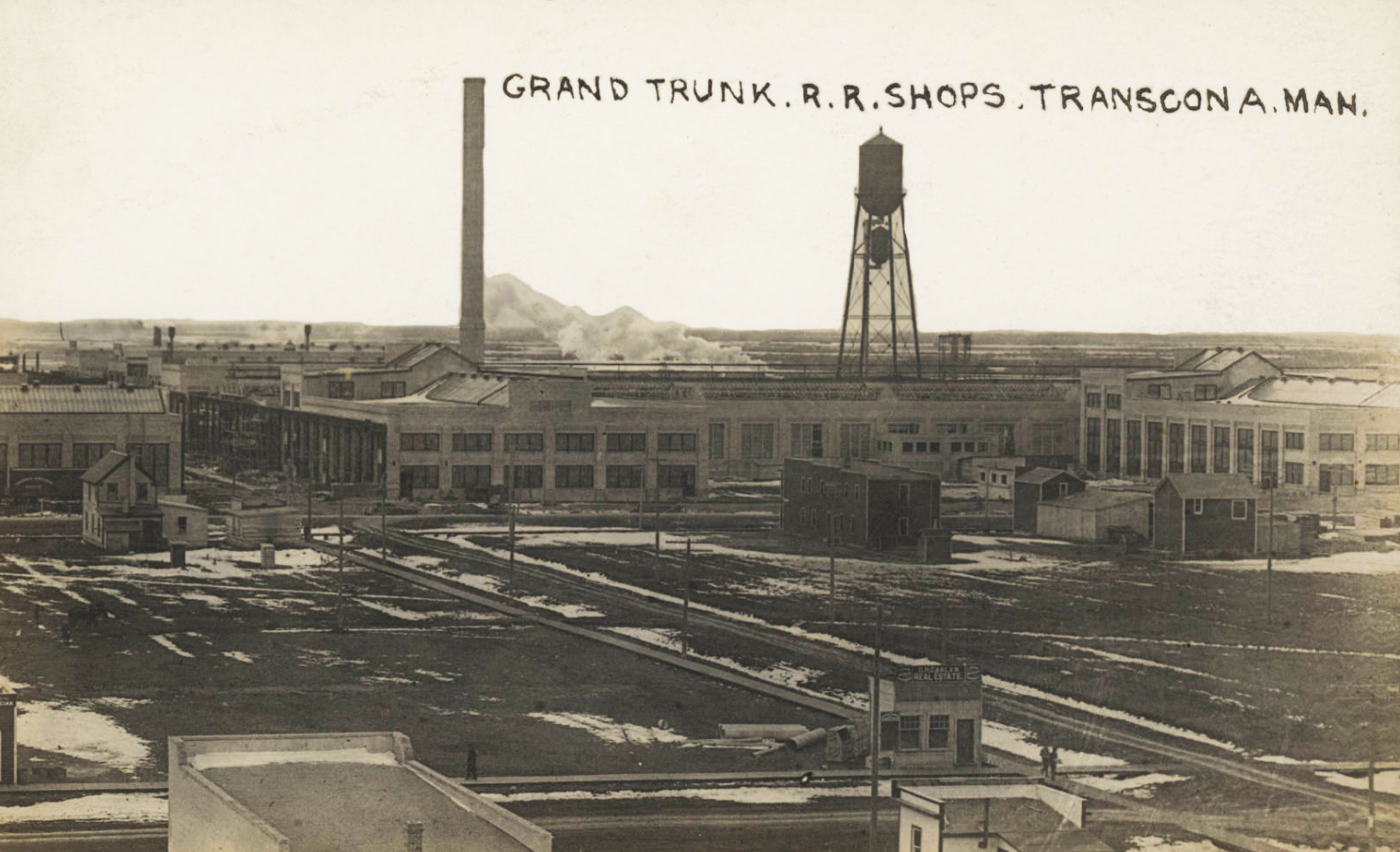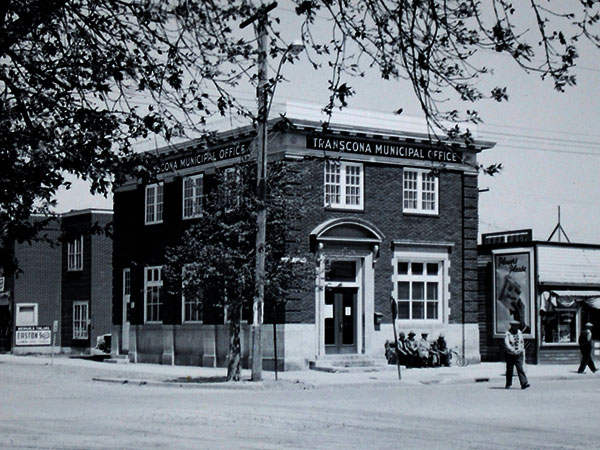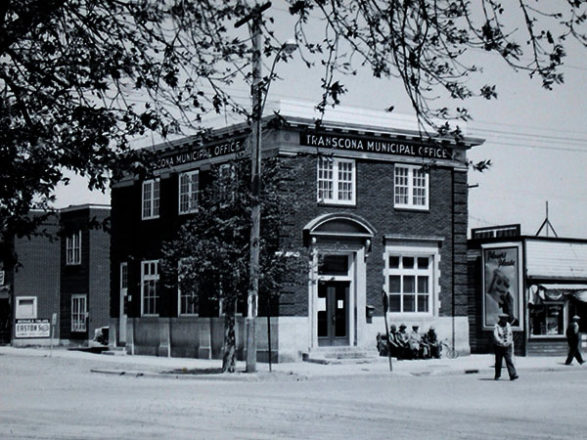
/ Blog
April 17, 2020
The Transformation of the Transcona Bank of Toronto
The historic Bank of Toronto Building in the community of Transcona is the fitting home of the Transcona Museum. Originally designed to safely stow fiscal wealth, it now protects the community’s treasured history. A stately brick building that has stood the test of time, the bank has been a constant in a community that has changed drastically over the last century. It is an excellent example of adaptive reuse, that has allowed a community landmark to flourish while welcoming the public to celebrate their history!
In the days before the Unicity Agreement of 1972, which amalgamated surrounding towns with the City of Winnipeg, Transcona was an independent town with its own municipal government and its own unique history. Transcona was a small community that sprung up alongside the railway tracks to service the railway industry. Its origins trace back to 1907, when the Grand Trunk Railway (later the Canadian National Railway) purchased 800 acres of land east of the City of Winnipeg to build its shops. The shops were needed because the Grand Trunk Railway was building the Grand Truck Pacific Railway. This railway would run from the west coast of Canada to Winnipeg, where it would meet up with the National Transcontinental Railway (also operated by the Grand Trunk Railway), which would run from Winnipeg to the east coast of Canada, creating a third transcontinental railway in Canada.
The area purchased for the Grand Trunk Railway’s shops turned out to be rather swampy, requiring four feet of fill to be put down before construction could finally start in 1909. Anticipating the development that would grow around the new shops, the name Transcona was chosen for the future town. Transcona was a merger of two words, transcontinental, for the National Transcontinental Railway, and Strathcona for Lord Strathcona, who played a pivotal role in Canada’s railway development. With the construction of the shops the community quickly boomed, with houses, a hotel and theatre, all being built before the town was incorporated in 1912.

The Grand Truck Railway’s Transcona shops in the early 20th century. Source: PastForward.
Easy access to the railroad and a growing community were appealing assets to other industries moving into Manitoba, as such the Bank of Toronto which soon turned its attention to Transcona. As early as 1910, the Bank of Toronto had operated a small wooden banking hall at 309 Bond Street and benefited from a steady flow of industry and individuals. Though the Town of Transcona had faced earlier financial troubles, even declaring bankruptcy by the mid-1910s, the Bank of Toronto remained firmly at home on Bond Street. In 1911 it moved across the street and erected a much more formal wooden building. The second location lasted 13 years, with the bank hardly relocating at all.
Construction of a new Bank of Toronto began in 1924 at the corner of Regent Avenue and Bond Street. The new location would have been next door to the former branch had the building not been turned to face Regent Avenue, with an address of 141 Regent Avenue West. Local Architect, Major George W. Northwood, was hired to design the new and improved Transcona branch. Northwood began his career in 1905 as an architect in Winnipeg, and designed his first building the Ryan Block in 1906. Across the first decade of Northwood’s busy career, he partnered with fellow architects William Wallace Blair and Cyril Chivers to design many Winnipeg buildings. In 1914, alongside hundreds of fellow Canadians, Northwood enlisted to serve in World War One.
Serving in the 8th Canadian Battalion, Northwood fought in Europe for the next four years and was even captured by German forces in 1915. In recognition of his service, Northwood was promoted to the position of Major and returned home to Winnipeg in 1918.
While away, Northwood left his projects in the hands of business partner Raymond Carey. The partnership between Northwood and Carey continued on after Northwoods return, until 1922 when Northwood began pursuing independent projects. Between 1922-1926, Northwood operated his own architectural practice, during which time he was hired to oversee the construction of the Bank of Toronto’s new Transcona branch.
The Transcona Bank of Toronto’s stately design appears to be the standard for Bank of Toronto branches across Manitoba, and it is likely that the designs came from a corporate office in Ottawa. Similar to other Bank of Toronto branches, the Transcona branch is a red bricked structure with classical detailing. It sits on a limestone foundation, and features an arched limestone doorway. Window frames were painted beige to contrast with red brick. Just under the cornice along the top of the facade, “BANK OF TORONTO” was carved into the stone.
The first floor of the building offered banking services, vaults, and offices, while the second floor served as a full apartment for a bank employee. This was at the time, standard procedure. Often, it would be either an accountant or a bank manager who lived upstairs. The theory behind this was simple: the chances of robbery were lower if someone was living in the bank full-time.
Not that this completely prevented robberies from occurring. On the morning of October 16th, 1930, three armed men entered the Bank of Toronto and fled with $12,000 (or $177,782.61 in 2020 money!) causing a media frenzy. Police were quick to act and led an in depth search through both Transcona and Winnipeg. Border guards were warned to keep an eye out for the men, should they try to flee to America. Papers covered the story with fervour, reporting on the dives and pool halls police were combing as they hunted for the robbers.
The manhunt was brief. By October 17th, the police had interviewed 200 individuals and apprehended three men (Harry Herman, Joseph Wyrozub, and Lester Gywnn), all of whom were charged with armed robbery. The trial received similar media attention, and involved thirty witnesses. Ultimately, the three men were all tried for armed robbery and all sentenced to prison time. The Transcona Museum has an excellent blog post chronicling the robbery, manhunt, and trial which can be read here.
In 1941 the Bank of Toronto relocated again, this time across the street to a similarly designed building that was once owned by the Bank of Montreal. The Town of Transcona, needing new offices, purchased the Bank of Toronto Building in 1943 and turned the building into municipal offices. The town’s Health and Welfare Department, and the Parks and Recreation Department had offices in the bank. To make room for these departments, the second floor apartment was renovated into smaller office spaces. They did however, keep the bathroom and kitchen to use for municipal staff. Town offices, at the time, were spread out between the Bank of Toronto Building and Transcona’s public building. Indicative of Transcona’s steady growth, the town was incorporated into a city in 1961.

The Bank of Toronto, seen here in sometime between the 1940-1960s. Source: Archives of Manitoba.
Canada’s Centennial in 1967 prompted celebrations across the country, Transcona included. At an April city council meeting, councillors approved a motion to create a municipal history museum. In short order, funding was secured and a space set up in the basement of the Transcona Public Library. The Transcona Museum officially opened to the public on October 16th, 1968!
After two years in the basement of the Transcona Public Library, the museum began the process of relocating to the new Roland Michener Arena. By the time the Transcona Museum reopened in the arena, the civic structure of Transcona had changed. The 1972 Unicity Agreement was signed, essentially merging surrounding municipalities with the City of Winnipeg. The Municipal Offices in the Bank of Toronto Building were no longer needed and the doors were closed.

The Transcona Municipal Offices at 141 Regent Avenue. Source: Murray Peterson.
In 1979, the Transcona Museum was yet again looking for a new home. Two choices were given: either 401 Pandora Avenue West, or the Bank of Toronto Building at 141 Regent Avenue West. As we all know today, the museum chose the Bank of Toronto as its new home and began the process of moving artifacts and exhibits over in 1981. The former banking hall held it’s own historic appeal; on July 14th, 1980 the building was designated as a historic building by the City of Winnipeg, and is one of only two buildings in Transcona to receive one. The Transcona Museum held its official re-opening ceremony in June of 1983.
Through the adaptive reuse of Bank of Toronto Building, the Transcona Museum helped save a part of Transcona’s vibrant history. Now nearly 100 years after the bank first opened its doors, the Transcona Museum has filled it with a large collection of artifacts related to local history that proudly tells the story of the community. The museum has now flourished in its new home and is a regular participant in Doors Open Winnipeg and has also taken on the task of conserving CN2747, the first steam locomotive built in western Canada. The Bank of Toronto building is a real testament to the longevity of historical buildings, their adaptability and functionality through changing times, always ready to serve their community!
THANK YOU TO THE SPONSOR OF THIS BLOG POST:

Written by Sabrina Janke and staff on behalf of Heritage Winnipeg.
SOURCES:
141 Regent Avenue | City of Winnipeg Historic Buildings Committee
George Northwood | Dictionary of Architects Canada
Transcona Centennial | CBC Manitoba
Transcona: Winnipeg's Railway Town | George Siamandas
Transcona Bank Robbery | Transcona Museum
Heritage Winnipeg Files











